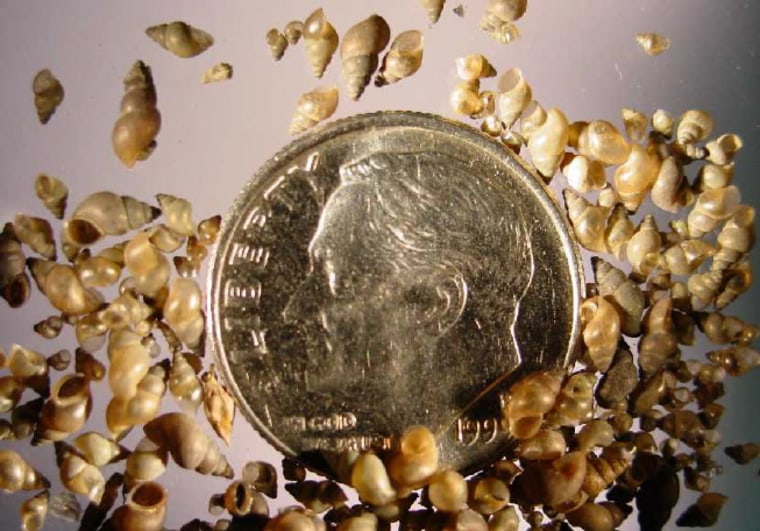Scientists worry that a rapidly reproducing, tiny invasive snail recently found in Lake Michigan could hurt the lake's ecosystem.
The New Zealand mud snail joins a long and growing list of nonnative species moving into the Great Lakes, threatening to disrupt the food chain and change the local environment.
Scientists checking Lake Michigan water samples earlier this summer found a population of the New Zealand mud snail, the Illinois Natural History Survey said. They grow to only a few millimeters — several dozen could sit on the surface of a dime — making them hard to spot.
The snails reproduce asexually and in large numbers, and have no natural predators in North America, Kevin Cummings, a scientist who works for the Natural History Survey, said Thursday.
That means they could quickly spread, at high enough densities to out-compete native invertebrates for food and living space, he and other scientists say.
"It's hard enough to contain a species once it makes its way into nonnative waters," Cummings said in a statement. "When each mud snail has the ability to produce large quantities of embryos without a partner, you've really got a problem."
Already in other lakes
Scientists won't know for some time how well the mud snail will do in Lake Michigan, but it has been in Lake Ontario since the early 1990s and lives in high numbers there and in Lakes Superior and Erie, said Rochelle Sturtevant, an ecologist with the National Oceanographic and Atmospheric Administration's Great Lakes Environmental Research Laboratory in Ann Arbor, Mich.
The snail is native to New Zealand but is now found in several western states and all the Great Lakes except Lake Huron. It is carried in ships' ballast water and, once in lakes and streams, hitches a ride on boats and even the clothes worn by human waders.
"Where they've gotten into streams in the western part of the country, they've caused a lot of problems," said Sturtevant. "They're taking over space that should have other native species living in it."
Plenty of invasive species have made homes for themselves in the Great Lakes. Zebra and quagga mussels are a threat to the region's $4 billion-a-year fishery, eating up algae that is the lowest link in the lakes' food chain.
And some invasive species make it possible for others to follow, Sturtevant said. The round goby, an aggressive fish native to Eurasia, now thrives in the Great Lakes because it eats zebra mussels.
Those are just a handful of what Sturtevant says are now at least 186 invasive species in the lakes.
Ship ballasts blamed
Environmental groups are particularly critical of the role oceangoing ships play in introducing species like mussels to the lakes.
Ships that aren't loaded down with cargo fill their ballast tanks with water for better stability when they're on the ocean, then empty the tanks when they arrive in port. That ballast water often contains any number of species, from microscopic organisms to mussels and fish.
The U.S. Environmental Protection Agency introduced a plan earlier this summer that would require ships to dump ballast water at least 200 miles from shore. But the plan, called a permit, includes an exemption for loaded ships.
Environmental groups are particularly critical of the EPA's plan.
"I could sum it up in one word: nothing. The permit doesn't change a thing," said Joel Brammeier, vice president for policy at The Alliance for the Great Lakes.
The shipping industry, including the U.S. Great Lakes Shipping Association, has said it supports the idea of treating ballast tanks to kill potentially invasive species. But industry officials say that while treatment is being researched, so far there isn't a feasible way to do it.
